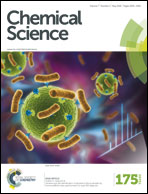Benzo-thia-fused [n]thienoacenequinodimethanes with small to moderate diradical characters: the role of pro-aromaticity versus anti-aromaticity†
Abstract
Open-shell singlet diradicaloids have recently received much attention due to their unique optical, electronic and magnetic properties and promising applications in materials science. Among various diradicaloids, quinoidal π-conjugated molecules have become the prevailing design. However, the need for a fundamental understanding on how the fusion mode and pro-aromaticity/anti-aromaticity affect their diradical character and physical properties remains unaddressed. In this work, a series of pro-aromatic benzo-thia-fused [n]thienoacenequinodimethanes (Thn-TIPS (n = 1–3) and BDTh-TIPS) were synthesized and compared with the previously reported anti-aromatic bisindeno-[n]thienoacenes (Sn-TIPS, n = 1–4). The ground-state geometric and electronic structures of these new quinoidal molecules were systematically investigated by X-ray crystallographic analysis, variable temperature NMR, ESR, SQUID, Raman, and electronic absorption spectroscopy, assisted by DFT calculations. It was found that the diradical character index (y0) increased from nearly zero for Th1-TIPS to 2.4% for Th2-TIPS, 18.2% for Th3-TIPS, and 38.2% for BDTh-TIPS, due to the enhanced aromatic stabilization. Consequently, with the extension of molecular size, the one-photon absorption spectra are gradually red-shifted, the two-photon absorption (TPA) cross section values increase, and the singlet excited state lifetimes decrease. By comparison with the corresponding anti-aromatic analogues Sn-TIPS (n = 1–3), the pro-aromatic Thn-TIPS (n = 1–3) exhibit larger diradical character, longer singlet excited state lifetime and larger TPA cross section value. At the same time, they display distinctively different electronic absorption spectra and improved electrochemical amphotericity. Spectroelectrochemical studies revealed a good linear relationship between the optical energy gaps and the molecular length in the neutral, radical cationic and dicationic forms. Our research work discloses a significant difference between the pro-aromatic and anti-aromatic quinoidal compounds and provides guidance for the design of new diradicaloids with desirable properties.
![Graphical abstract: Benzo-thia-fused [n]thienoacenequinodimethanes with small to moderate diradical characters: the role of pro-aromaticity versus anti-aromaticity](/en/Image/Get?imageInfo.ImageType=GA&imageInfo.ImageIdentifier.ManuscriptID=C5SC04706D&imageInfo.ImageIdentifier.Year=2016)

 Please wait while we load your content...
Please wait while we load your content...